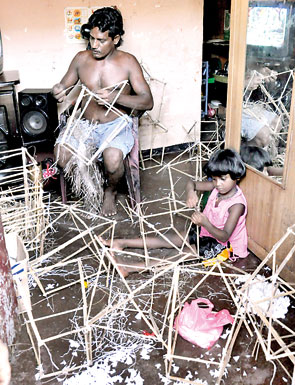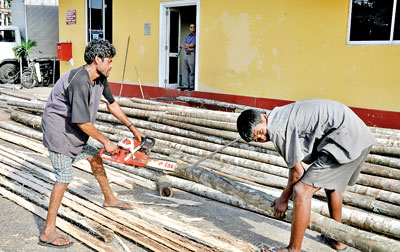News
Lights, food, action! Vesak spirit undimmed
With the Avurudu celebrations barely over, Vesak lanterns, pandals and other decorations are already taking shape in houses and workplaces, and busy lantern-makers say the Vesak spirit has beaten the cost of living blues. Hard at work is S. A. Ariyarathne, 57, who started making lanterns a week ago, with customers attracted by the family’s 28-year history of making the dainty frames and hanging them at the Kirulapone Vesak pola for sale.

It’s a family affair: This little girl helps her father to make lantern frames
Lantern and decoration sellers predict that sales will be as good as in previous years despite the higher cost of living. “We make around 1000 lanterns of different shapes every year and sell them to the people who start coming a week before Vesak to buy them. Almost all our lanterns are being bought even though the prices of the lanterns have increased over the years,” he said. He sells a lantern structure for Rs.60 and a finished lantern Rs.200 – 400 depending on the decorations used.
“There’s no religious or ethnic barrier to celebrate Vesak, and we get Tamil, Muslim or Catholic customers who are attracted to the colourful and pleasing decorations. People buy these items no matter how the prices of the items increase,” he said.
Like the different kinds of lanterns being sold and made in our houses, pandals also are an essential part of Vesak. A beautiful pandal planned in Kirulapone, depicting the Vidura Jathakaya, will 60 feet high, with 50, 000 coloured bulbs. It is being funded by Piyasena Senarathne.
There is dismay over the high cost of exhibiting pandals this year. “The cost of the Kirulapone pandal will be about Rs.2.5 million, and we plan to exhibit it for seven days. The Ceylon Electricity Board has asked a deposit of Rs.275, 000. But at the end of the week we won’t receive any reimbursement as the Board will make deductions for service charges too,” said the pandal architect, Shamarathne Alagiyawanna.
Disappointed but undeterred, he is considering using a generator, which he said is cost-effective and efficient. Wijesiri Wickremasinghe, who is directing the Pepiliyana pandal, funded by Daya Group Chairman Daya Gamage, explained that due to the high cost of living the expenses of the pandal would be high. “But we will continue to exhibit the pandal this year as we have been doing it for the past seven consecutive years,” he said.
The most striking aspect of Vesak to most of us, let’s admit, is the tempting dansals sited at junctions or next to temples.
Most of the dansal organisers have not begun collecting money from – most of the time – willing contributors but they hoped people would rally behind the programs as usual this year.
Nilantha Perera, 43, who used to be one of the main contributors to the Borelesgamuwa fried rice dansal, is heading the consecrated event this year. “This is a time where most of the people from the city and the children get together to give a decent meal to the devotees who go to the Pillewa temple or the Bellanwila temple and to the others who come to see the Vesak sights,” he said. The dansala, which starts at 7pm on May 24, feeds more than 1000 people.

Getting ready to put up a pandal in Kirulapone. Pix by Susantha Liyanawatte
“This year, the costs of most of the food products are considerably higher but we can’t let that get on the way of a good deed.”
Thilak Sanjeewa, a 45-year-old father of two from Ratnapura, is organising a chickpea dansala in his town as he has been doing for the past four years with other colleagues of the Ratnapura Three-Wheeler Association.
“This time we didn’t get the funding we expected but we will carry out the dansala throughout Vesak day,” he said, adding that the cost of products had affected the project. “We have to work extra hard and go to many people to get funds but we will do whatever is needed to have a good dansala as we always do,” he said. Thilak and his friends were this week collecting firewood for the great day.
Thirty-eight-year-old Gayan Jeewan from Kandy is planning a rice dansala with his relatives, fears that this year’s event would not be as successful as it was in the past.
“People are not willing to contribute for such deeds any more and we can’t go to people and make them give us money or food products because we don’t want to burden them. “At the beginning of next week, when we start to collect money and have a sufficient amount we’ll put on a dansala, or else we’ll give the money we collected to the village temple,” he said.
While Gayan is struggling with funds, Amila Kamara, 28, said that the people in his area, Monaragala, are going to use the food they get from their gardens for their dansala. “We are going to organise a jack-fruit sambal (thambapu kos) since people like to eat it and it is found in plenty in our area. We are hoping to use everything that we get in our gardens for the dansala this time, “ he said.
The Principal Public Health Inspector, Y. I. Ganawardena, said nearly 1000 inspectors will be on duty this Vesak to monitor and give advice to the organisers on food hygiene. Inspectors around the country would be on special duty to raid dansals that are not up to standard.
“We will be monitoring how the people are preparing food before the Vesak day and keep a close watch on the kitchens and the way the food are served,” Mr. Ganawardena said, explaining that hundreds of people could get sick if even one dansala served bad food.
The Chief Medical Officer of the Colombo Municipal Council, Dr. Pradeep Kariyawasam, said 50 Public Health Inspectors would be deployed in Colombo city. Organisers had been asked not to employ people with colds, coughs and skin diseases to prepare food. Food preparation should not be exposed to dirt and dust, he said.
Follow @timesonlinelk
comments powered by Disqus

